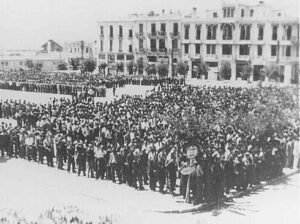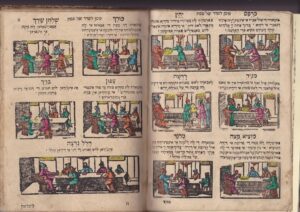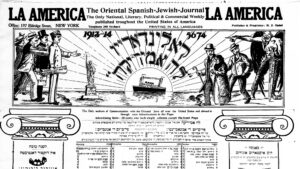What is Ladino?

Ladino is the language of the Sephardic Jews that were expelled from Spain by Ferdinand and Isabella in 1492. Ladino, otherwise known as Judaeo-Spanish, is a beautiful mix of old Castilian Spanish and other languages. The Jews that were expelled from Spain took their language with them across the Mediterranean and preserved it for over 500 years. Over time, the medieval Castilian Spanish was enriched with Greek, Italian, French, Portuguese, Arabic and Turkish words. Just like Yiddish is a Jewish hybrid language of German, so too Ladino is a Jewish hybrid of Spanish.
Ladino has been written in at least three different Hebrew scripts – Solitreo (Hebrew Cursive Script), Rashi script and Meruba script (Hebrew Square script). In the early twentieth century, Ladino began to be written in Roman characters as well. Many Ladino speaking Jews wrote songs, poems and commentaries in Ladino as well as circulated Ladino news journals.
Is Ladino Endangered?

The last generation of native Ladino speakers were born around 1945. There are a little over 100,000 native Ladino speakers left in the world and most of them are over 70 years old. When this generation is gone, there will be no more native Ladino speakers left. The population of Ladino is so small that UNESCO declared Ladino an endangered language in 2002.
Why did Ladino Decline?

The Holocaust sadly wiped out 90% of the world’s Ladino speakers. In addition, the secularization of communities in the early 19th century where Ladino was once spoken also led to its decline. Ladino was associated with a religious, traditional way of life. However, newer generations seeking modernism slowly abandoned their roots and language. Moreover, with the rise of Zionism and the Jewish state, many members of the Sephardic communities immigrated to Israel. The Israeli ideology to speak only Hebrew in Israel caused the gradual loss of Ladino among the younger generation as parents did not transmit it to their children. Most of the Ladino speakers still left in the world live in Israel and Turkey. For the most part though, Ladino has not been passed on to younger generations and is at risk of extinction.
Why is Ladino important?

Languages are more than words and a means of communication, they are the fabric of culture and society. Ladino is an important tool for transmitting the rich history of Sephardic Jewry as well as an integral marker of Sephardic community and tradition. It is also a rich source of poetry, proverbs, folktales and news sources. The language alone is a testimony to the persecutions and condemnations of the Spaniards and of the Nazis and should be preserved at all costs.
Efforts to Revive Ladino

In an ongoing effort to revive Ladino, there have been
numerous online Ladino zoom classes and new children’s books to help younger people learn the language. Many Sephardic children also attend The Sephardic Adventure Camp in Seattle, Washington. Established in 1950 by the greater Sephardic community, this orthodox sleepaway camp was developed to help preserve the unique Sephardic-Ladino traditions that are quickly being forgotten. Aside from spending their summers in the beautiful Pacific Northwest, campers learn Ladino liturgies during davening as well as in campfire sing-a-longs. Extra points are awarded during color war if Ladino is integrated into a banner and email correspondence from the administration to parents always includes a Ladino anecdote or message. The Sephardic Adventure Camp is the only Sephardic-Ladino camp of its kind in the world.
Ladino Newspapers

The Ladino press of the United States, still largely unexplored, is one of the most vital sources for the history of Sephardic Jewry in early twentieth-century America.
The Sephardic Jews in the United States never numerically rivaled the two and a half million Eastern European Ashkenazim who arrived on American shores from 1881 to 1924, nor did the readership of the Ladino press ever remotely match the quarter of a million plus who subscribed to the Yiddish Forward during its peak in the 1920s, however, the Ladino press was still prolific and united the Sephardic-Ladino community for numerous decades before WWII. Below are a list of the Ladino newspaper and periodicals.
El Amaneser (“The Dawn”) was a Ladino monthly newspaper published in Istanbul that is still in print today.
La Epoca – was a Ladino language newspaper published between 1875 and 1911 in Salonika, Greece. Published for almost forty years, it was the leading Ladino publication in the Empire and first Ladino newspaper in Salonika.
Salom – a Jewish weekly newspaper published in Turkey. Its name is the Turkish spelling of the Hebrew word שלום. It was established on 29 October 1947 by the Turkish Jewish journalist Avram Leyon. It is printed in Istanbul and is published every Wednesday. Historically, Şalom, the Jewish weekly newspaper in Turkey was written exclusively in Ladino, but in 1984 it switched to Turkish, apart from one Ladino page.
El Tiempo – a Ladino language newspaper published in Constantinople/Istanbul in the years 1872–1930. El Tiempo was the first Ladino newspaper published in Istanbul. It was also the longest-running daily Ladino newspaper in the city. It was later being converted into a biweekly newspaper.
La Vara (“The Stick”) – a Ladino language newspaper, published weekly from 1922–1948 in New York City. As a national Sephardi Jewish newspaper in the United States, it was edited by Albert Levy, a Salonican Jew, and had a circulation of 16,500 in 1928. La Vara was the longest running Ladino newspaper in the United States.
